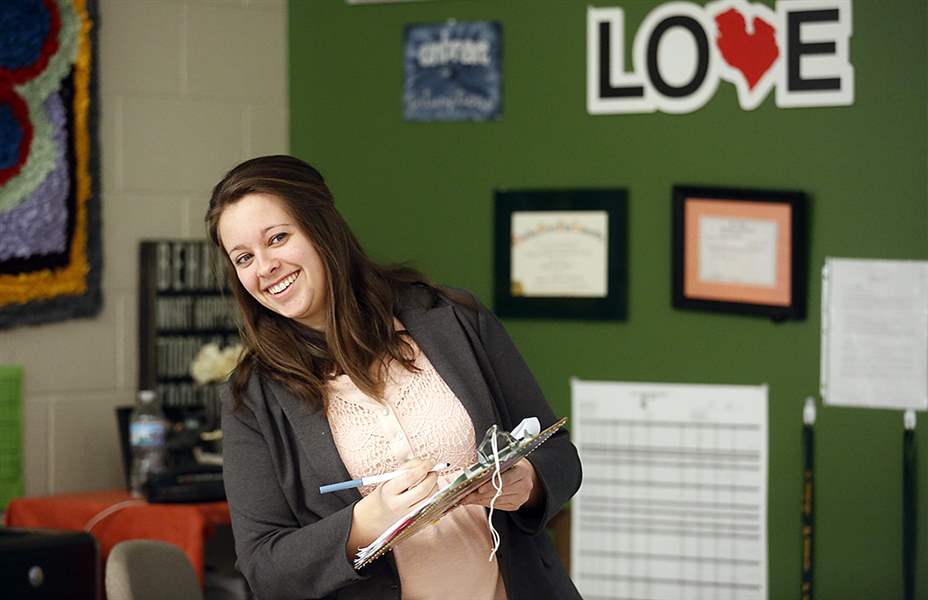
TPS course to look at fact-checking news
Start teacher leading media, politics class
3/20/2017
Kristin Schnerer takes attendance for her geography class at Start High School. Miss Schnerer received approval from the Toledo Board of Education to teach a new course on media and politics.
THE BLADE/AMY E. VOIGT
Buy This Image
Kristin Schnerer calls herself a “news junkie.”
The Start High School social studies teacher engages her classes in discussions about current events, and fact-checks students when they spout false stories spread on Facebook.
The task of sifting through what is true and what is not, what is opinion or fact, what is journalism or advertising has gotten trickier as sources of online information proliferate and the heat of political rhetoric rises.
Fake news from satirical or partisan websites became a focal point in recent months — from Donald Trump’s White House to pundits breaking down his 2016 presidential win.
Miss Schnerer has a timely and practical solution: Teach students how to analyze the news.
The Toledo Board of Education recently approved a course she will pilot next school year that aims to do exactly this. Media and Politics — a half-credit elective course for juniors and seniors — is like no other class at Toledo Public Schools.
“There has honestly never been a better time for this class, and I hope that other people, other social studies teachers, can look around and say, ‘We need this kind of class,’ ” she said.
More than 60 Start students already plan to enroll.
“I feel like this class is going to widen my horizons [to] be an educated voter,” said Adriana Ganzel, a 16-year-old sophomore who noted she can vote in two years. “It will help me be able to examine all the facts and determine who I think should be in power.”
The Stanford History Education Group at Stanford University showed just how unsavvy youth are at evaluating Internet news sources.
An 18-month study released in November found that more than 80 percent of middle schoolers confused a paid advertisement marked as “sponsored content” as a real news story.
Researchers also found that many high school students ignored critical details when tasked with trying to distinguish between legitimate online news sources and dubious ones.
“We were taken aback at how poorly students performed across the board,” said Joel Breakstone, the group’s director. “We were really struck at how much students struggled to make sense of the content online.”
There’s “a real interest” among teachers and schools to weave more media literacy into existing curricula or create new classes, he said. A course devoted to media literacy is “a great starting point,” but teachers also should look for ways to make connections in other classes.
Sylvania, Perrysburg, and Washington Local don’t offer a specific course tailored to understanding the news, but teachers in those districts incorporate skills into other courses.
Nancy Patterson, a Bowling Green State University professor and president of the Ohio Council for the Social Studies, said critical thinking is part of government, history, economics, and geography classes.
“That’s always been a part of strong civic education to be able to critique the sources that you use to find out what’s true,” she said.
TPS supported Miss Schnerer’s proposal because her class will provide “real-world learning” that helps students separate “fact from fiction,” said Jennifer Lawless, the district’s executive director of college and career readiness.
“I think it is especially timely. We’re trying to graduate college and career-ready students, but also good citizens, and every good citizen has that ability to read into the media, analyze,” she said.
In Miss Schnerer’s class, students will analyze news stories from multiple perspectives: for example, how Fox News reports on a political story versus CNN, or how Toledo television and print outlets cover the same gun shooting.
“They tend to just read and think what other people tell them, and that’s a characteristic of this generation, of these age kids,” she said.
A research project will require students to pick a historical event and study how media affected politics and politics affected the media.
She expects passionate discussion on controversial topics, but she wants to keep classroom conversation civil and plans activities to cut the tension when needed.
Zachary Hall, a 16-year-old sophomore and fan of President Trump, said he seeks out conservative viewpoints when he delves into political news.
“That’s my side, of course I’m going to listen to Fox News,” he said.
Still, he plans to take the class, which he thinks will be interesting and which will broaden the sources he typically reads.
“Trust me, I take a lot of heat for who I support,” he said.
Miss Schnerer, who is in her third year of teaching, started thinking about creating the course last school year when she incorporated current events into her economics class. She said she mostly tries to leave out her personal opinions and instead expose students to all angles of a divisive topic.
She displays an easy rapport with students and banters affably while keeping class on track during a recent geography class. Her enthusiasm for the media and politics course is one reason Christian Spetz, 16, wants to enroll in it.
He’s looking forward to the classroom debates, which he thinks will help sharpen everyone’s views.
“I feel so much better at the end of the class period or at the end of the day that I’m still friends with that person even besides our differences,” the sophomore said.
If district officials deem the pilot course successful, it could be offered at other Toledo high schools during the 2018-2019 school year.
Contact Vanessa McCray at: vmccray@theblade.com or 419-724-6065, or on Twitter @vanmccray.